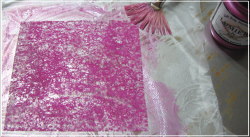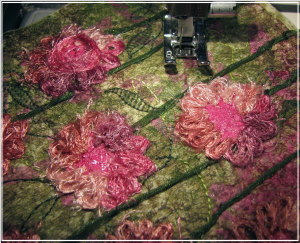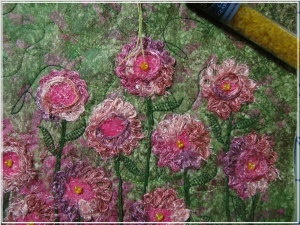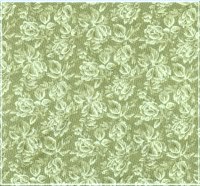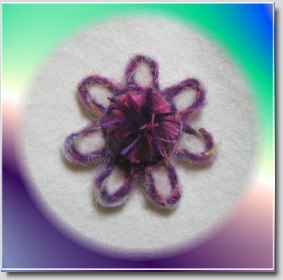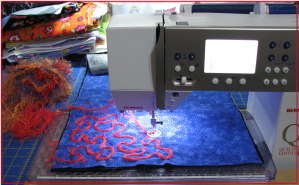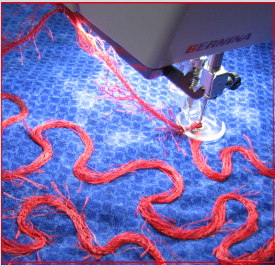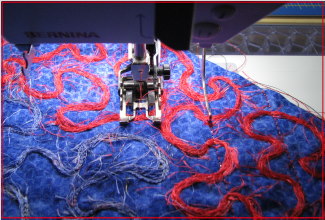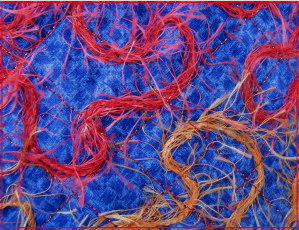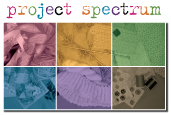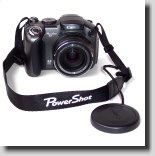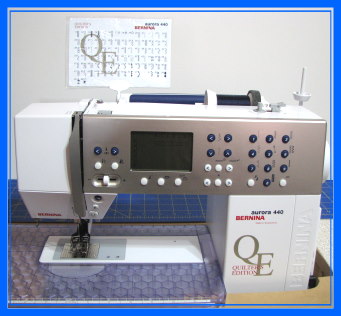
There’s been a lot of interest in the Bernina Aurora 440 QE (Quilter’s Edition) from the time it entered the market place. The focus of all the attention rests on the BSR (Bernina Stitch Regulator) attachment. The 440 QE is not the only computerized free arm sewing machine that Bernina offers with this attachment, but it is a midrange Bernina machine, making it more widely available to those who can’t swallow the price of the 730 model or simply don’t need all the features that a top-of-the-line machine offers. (A friend of mine describes the price tags this way: “These are machines you drive home.”)
Although the BSR attachment is deserving of the attention it has received, the 440 QE offers sewers, quilters, fiber artists, and other artisans a host of other features worth noting. I can’t promise that this post will cover every single bell and whistle, but I will give you a list of my favorite things about this wonderful sewing and embroidery machine.
1. The Manual – Bernina writes a great manual that is detailed and easy to understand.
2. Reinforced Soft Cover – Bernina includes a carrying case with compartments for accessories.
3. Accessory Box – I love this thing. It attaches to the back of the machine for easy transport. It detaches for desk top use. There are compartments for bobbins, presser feet, sewing machine needles, and two drawers for other small parts.
4. Walking Foot – A two sole walking foot with seam guide comes standard with the machine.
5. Needle Threader – It works; what more can you ask for. (There are also three thread cutters on the machine.)
6. Clear Slide On Table – There are seam allowance markings on the table as well as a ruler in inches and centimeters. Although listed as optional, my machine came with a slide on seam guide that is fully adjustable the entire length of the table.
7. Bobbin Winder – Bernina makes a great bobbin winder with a separate motor. This one even has a little thread cutter on the on/off switch. A collapsible vertical spool pin on the right side of the machine makes winding bobbins while sewing or embroidering quite easy.
8. Cool Fluorescent Light – What a difference this makes. I’ve actually burned my hand from the heat buildup on other machines.
9. Manual Presser Foot Pressure Dial – This dial is on the head frame, making it easily accessible.
10. Free Hand System – My Bernina 1230 has this feature as well. With a little push from your right knee, the presser foot raises and lowers.
11. Horizontal and Vertical Spool Pins – Sewers need both and Bernina provides them.
12. Thread Tension Adjustment Wheel – I like having the ability to adjust the upper thread tension manually. I use many different threads and make adjustments frequently. I also like having the dial in constant visual range rather than having to open a menu to see what my tension is set at.
13. Push Button Feed Dog – The feed dog button is easily accessible from the lower right hand side of the machine.
14. Slide Speed Control – I use this feature constantly. It also works when winding bobbins and with the BSR attachment.
15. LCD Screen – The LCD screen displays a lot of important information while you’re sewing, such as needle position (there are eleven to choose from), stitch width and length, needle up/down position, recommended presser foot, presser foot pressure, stitch selection (there are 379), mirror image, pattern begin/end, BSR, memory display, service notifications, and more. It’s a lot to take in at first, but after a little use your eyes become trained and it all becomes second nature.
16. Memory – Up to 90 stitches, letters, or numbers can be saved in memory along with stitch length, stitch width, and needle position alterations.
17. Multiple Brand Sewing Machine Needles – You can use various brands of sewing machine needles. I mention this because it’s not true of all machines. I have a top-of-the-line machine manufactured by another company that can only use Schmetz needles.
18. Quick Reverse Button – Bernina has conveniently located this button in the lowest position on the front of the machine (above the needle), making a few quick reverse stitches super easy. A continuous reverse function is also available.
19. Stitch Selection Card with Holder – Sometimes the stitches displayed on the LCD screen don’t match up well with the actual stitch, so Bernina has included a double sided stitch card with a picture of each stitch and its corresponding number. The machine handle has a clamp that holds the card.
20. Versatility – This is the thing that I find most endearing about the 440 QE. For general sewing, the machine has all the features you need, along with a powerful motor. For quilting, the machine has 32 built in quilting stitches and comes with a walking foot, a real bonus. Of course, the star of the show is the BSR attachment.
Additionally, the 440 QE is an embroidery machine when purchased with the optional embroidery unit. You will often find that midrange sewing/embroidery machines come with smaller embroidery fields. Not this machine. The large (145 x 255 mm) oval embroidery hoop is standard.
One more optional feature is the Bernina Needle Punch Accessory Set. I just purchased this attachment a few days ago as a backup to my Babylock Embellisher and will do a review once I’ve had time to work with it.
There you have my twenty favorite things about this sewing machine. I believe it only fair to mention a few things that I wish were different. The extent of the stitch width is 5.5 mm. It would have been nice to have at least 6 mm if not 7 mm. Also, since this machine is named “Quilter’s Edition,” patchwork foot #57 with the side guide should be standard. Instead, Bernina packs it with the patchwork foot #37.
So much goes into the decision making process when shopping for a new sewing machine. Give a lot of thought to the features you really need and test different brands and models. Also, visit online groups that focus on the machines in which you are interested. Here are the addresses for the Bernina Aurora 440 QE Yahoo groups:
http://groups.yahoo.com/group/Bernina_Aurora/
http://groups.yahoo.com/group/BSRfunction/
And now a little about the BSR. Whenever you try something new, it’s going to be a little awkward at first. If you’ve done any amount of free motion quilting, you know that a certain feel and rhythm develops over time. The BSR has its own feel and rhythm. The more you use it, the more accustom you become to it. At first, I considered it akin to training wheels on a bike. However, I now find myself using it more and more.
If you’ve been given the impression that it always makes perfectly even stitches, let me disabuse you of that idea. The human factor remains. If you jerk your hands you will have jerky looking stitches. However, if you keep a nice even flow to your movements, you will be rewarded with some of the nicest looking quilting stitches around.
The BSR does have a few quirks. It hates basting sprays, some more than others. I can get away with a light touch of 505, but anything else and I’ll have skipped stitches. Some have found that the BSR works best with top stitching needles. Others think it works best with silk thread. I have used Organ sharps with cotton quilting threads of different weights quite successfully, making tension adjustments along the way (it helps to make a chart of needles, threads, and tension adjustments).
The BSR that comes with the Aurora 440 QE only does straight stitches. The BSR included with the 730 also does free motion zig zag stitches. Personally, I don’t think I would use it for zig zag stitches even if had that capability, but it’s something to consider. There are two modes of operation to choose from and three free motion feet included with the attachment.
I hope you find this information helpful. If you’re interested in this machine, please visit your local Bernina dealership and give this fine machine a trial run.
~~~~~~~~~~~~~~~~~~~~~~~~~~~~~~~
N. Rene West
Time Treasured



